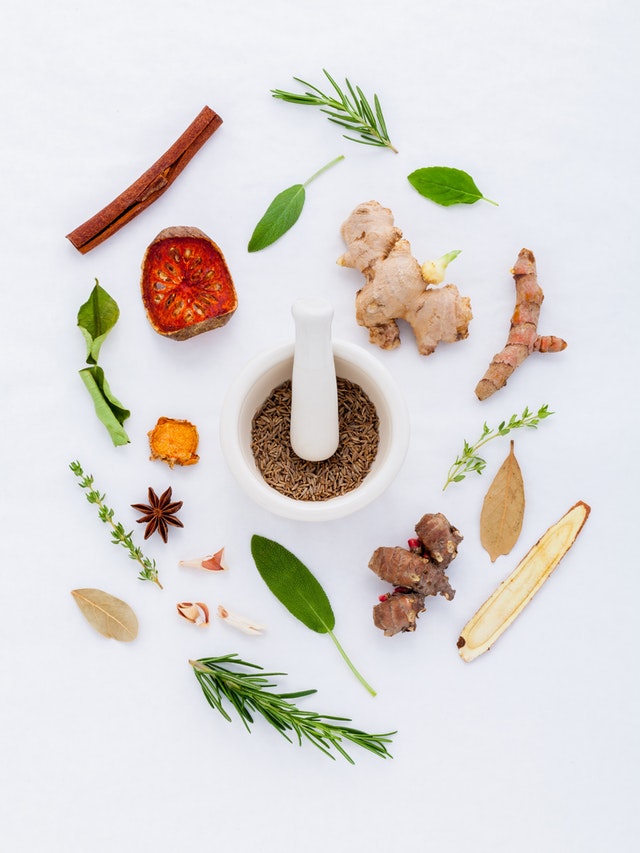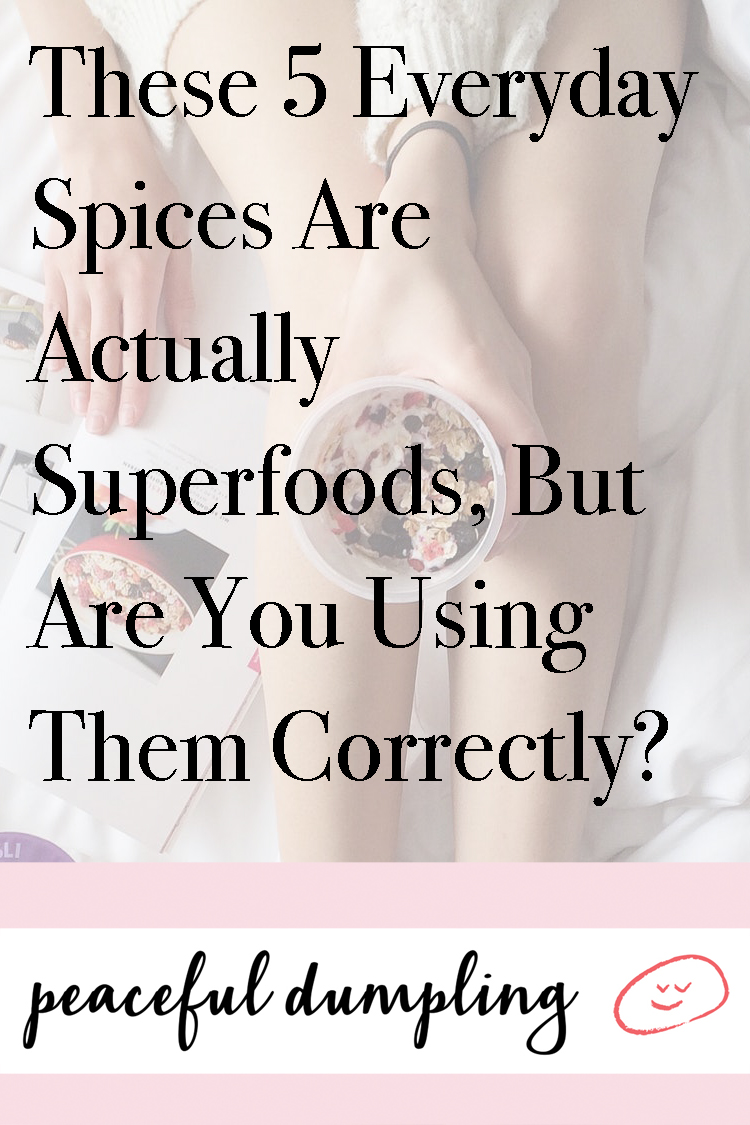
Follow your taste buds to better health with an array of spices!
Nature is a pretty smart cookie. She’s given us all sorts of tools to know when a certain food, behavior, or circumstance is good for us—namely, it makes us feel good—and when it’s not—pain, illness, this-is-wrong-type gut instincts. Whether or not we always listen to these things is the topic of another post entirely, but for now let’s proceed under the assumption that we follow nature’s lead on most things, especially when it comes to taste.
A key example of this subliminal messaging from nature is the appeal of spices. Simply put, spices make things taste better; ask any professional cook his or her secret to finishing a dish, and I bet she’ll say a just-enough dash of salt and pepper. When it comes to heavily processed foods, which are nutrient-poor, the taste-boost of spices is nature’s way of giving us more nutrition that these non-foods lack. We crave them because their taste (in addition to smell and color) tells us they’re healthy, making us want to eat more of them.
It may seem counterintuitive, then, that vegans rely so much on spices when it comes to cooking. If whole, plant foods are designed by nature to be perfect just as they are, why do we need to “improve” them with spices? All plants aren’t created equal, however, and just like the spices we add to them, each has its own nutritional specialty. Indeed the world of spices is perhaps as big as, or bigger than, the plants we put them on! My cupboard currently boasts about a dozen different jars of spices, whole and ground, of wildly different colors, smells, and flavors. And just as my type-A self ensures that each has its own perfect jar and place, each spice can deliver a specific nutritional and flavor element that can radically change a dish. Adding spices isn’t so much about making up for nutritional holes but complementing what nature provides in a perfect package. Think of spices like the delicate accessory that elevates a minimalist outfit, or the pop of color in an otherwise neutral-room. It transforms good to great—just the way nature intended it.
Here are some of the best spices to eat on the regular, according to the healthy-food bible by Dr. Michael Greger, How Not to Die. The book falls into the potential door-stopper category, but it’s a funny, accessible, and impressively researched guide to why and how we can all thrive on a vegan diet.
Cinnamon
The flavor and aroma of this homey spice comes from its oil, which is high in a compound called cinnemaldehyde that plays a big role in a healthy metabolism and insulin sensitivity; hence why the natural sweetener may reduce blood sugar, making it a good addition to your morning oats if you are diabetic. Just 1/2 teaspoon yields 100 units of antioxidants, too. Be sure to choose the Ceylon (sweet) variety over Cassia, which contains a harmful chemical called coumarin and is most commonly found in grocery stores today (keep reading for my cinnamon tips below).
Cloves
One of the most potent spices there is, cloves can be an acquired taste. Most baking recipes will call for 1/8 teaspoon, which always seemed to be a ridiculously small amount to me and maybe not even worth it—until I tried making pumpkin bread without it and thought I was eating another food entirely. Besides that classic autumnal flavor, just a pinch contains 140 units of antioxidants, and it’s been shown to have an antimicrobial property—perhaps why it’s used so often in the fall and winter, when viruses and other illnesses are rampant. Try adding a bit in your homemade toothpaste and your mouth will be even happier!
Ginger
If you’ve ever had an upset tummy (from nausea or motion sickness) or a headache, you know ginger is a good friend. Its anti-inflammatory properties are also beloved; just 1/2 teaspoon of fresh ginger relieves pain (including muscle cramps) just as well as OTC pain relievers like Advil.
Oregano
This pizza-partner is an antioxidant powerhouse, with 1 teaspoon yielding 150 units (20 times more than many other herbs and quadruple that of blueberries). It’s also rich in vitamins K and E, calcium, iron, manganese, and fiber.
Turmeric
1/4 teaspoon offers a healthy dose of curcumin, that bright yellow pigment that makes vegan tofu scramble and golden lattes irresistible. Curcumin may also prevent or treat a host of diseases affecting the brain, bones, and lungs and multiple cancers; is proven to speed surgical recovery; and may improve inflammatory conditions. To boost its bioavailability, combine with a 1/4 teaspoon of black pepper and/or a source of fat, which prevents the liver from trying to rid the body of it. Cooking turmeric will better protect your DNA, whereas eating raw turmeric from the root is better for inflammation. The possibilities are endless!
Best practices for vegan spicing:
When it comes to using spices on a vegan diet, many are guilty of going overboard as an attempt to “improve” the taste of produce and grains that, when coming off the Standard American Diet (SAD), can seem bland and flavorless. But remember nature’s attempt to make up for the faux-pas of our SAD standards: we can come to crave spices as a means to compensate for a lack of nutrition. So instead of thinking that you need tons of (expensive) spices to make veganism sustainable, think quality over quantity. Consider why you’d choose to buy a locally-grown, perhaps slightly more expensive heirloom tomato, bursting with natural flavor, over a can of tomato sauce that’s full of additives that make up for its taste and unnecessary extra spices. The heirloom is good enough on its own, enhanced by a pinch of salt or fresh basil, whereas the canned stuff needs even more seasoning to make it palatable. Maybe you save a few dollars on the latter, but what in the end you pay the price when it comes to flavor and effort.

By the same token, it’s worth going the extra mile to acquire high-quality spices. I used to buy (Cassia) cinnamon—which I added by the tablespoons-full to sweet and savory dishes alike—in bulk from places like Sam’s Club and Fairway. A 15-ounce jar costs around $8, but I’d go through it in a month! Then I discovered “real” Ceylon cinnamon in this organic, fair-trade variety I now buy by the pound. It costs almost three times as much, but I need only about a teaspoon to get the same kick of spice that the other variety gave. Plus, I know I’m getting a product that does more than just make me feel good, but is sustainable for the environment and farmers around the world.
If you’re looking to curate your spice cabinet, check out these bulk retailers that bring quality to you, no matter where you live:

What’s your favorite jar in your spice cabinet?
Also by Jen: Why A Sea Sponge Is The Zero Waste Essential That Will Transform Your Shower
Related: These Delish Spices Are Proven To Balance Mood & Make You Happier
Just Try Not To Become A 5-Star Chef After Watching These Vegan YouTube Channels
Get more like this—Subscribe to our daily inspirational newsletter for exclusive content!
__
Photos: Pexels.com; Molly Lansdowne

